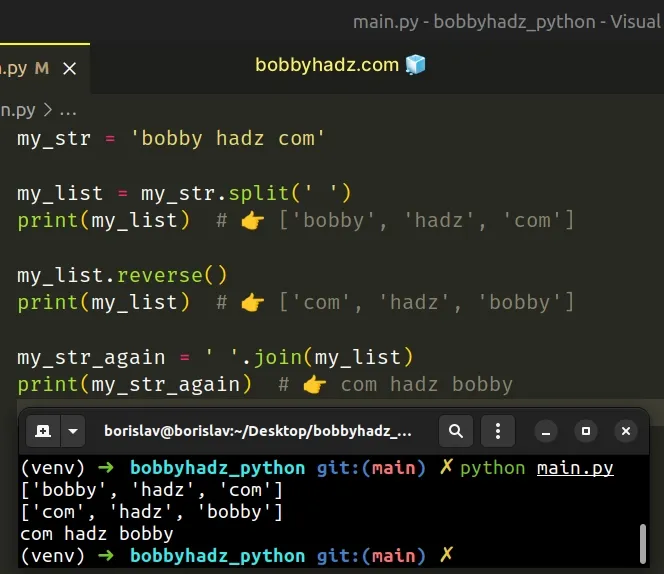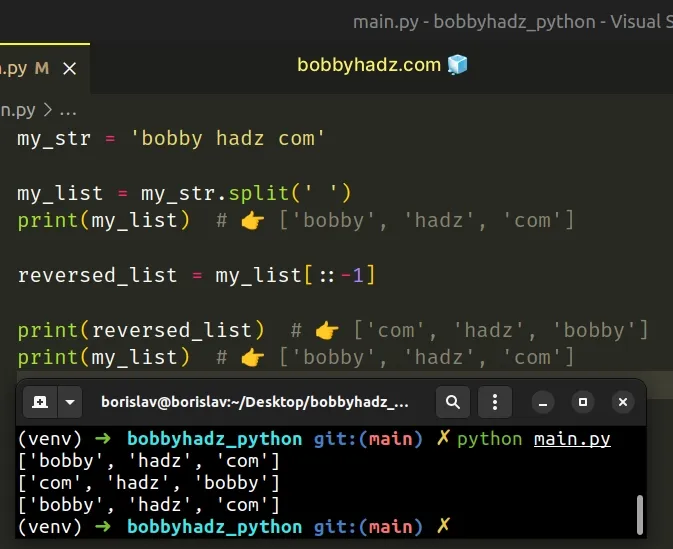Split a String, Reverse it and Join it back in Python
Last updated: Apr 8, 2024
Reading time·3 min

# Split a string, reverse it and join it back in Python
To split a string, reverse it and join it back:
- Use the
str.split()method to split the string into a list. - Use the
list.reverse()method to reverse the elements of the list. - Use the
str.join()method to join the list into a string.
my_str = 'bobby hadz com' my_list = my_str.split(' ') print(my_list) # 👉️ ['bobby', 'hadz', 'com'] my_list.reverse() print(my_list) # 👉️ ['com', 'hadz', 'bobby'] my_str_again = ' '.join(my_list) print(my_str_again) # 👉️ com hadz bobby

The first step is to use the str.split() method to split the string into a
list.
Here is an example that uses a comma as the separator.
my_str = 'bobby,hadz,com' my_list = my_str.split(',') print(my_list) # 👉️ ['bobby', 'hadz', 'com'] my_list.reverse() print(my_list) # 👉️ ['com', 'hadz', 'bobby'] my_str_again = ','.join(my_list) print(my_str_again) # 👉️ com,hadz,bobby
The str.split() method splits the string into a list of substrings using a delimiter.
my_str = 'bobby hadz com' my_list = my_str.split(' ') print(my_list) # 👉️ ['bobby', 'hadz', 'com']
The method takes the following 2 parameters:
| Name | Description |
|---|---|
separator | Split the string into substrings on each occurrence of the separator |
maxsplit | At most maxsplit splits are done (optional) |
The next step is to reverse the elements of the list using the list.reverse()
method.
my_str = 'bobby hadz com' my_list = my_str.split(' ') print(my_list) # 👉️ ['bobby', 'hadz', 'com'] my_list.reverse() print(my_list) # 👉️ ['com', 'hadz', 'bobby']
The list.reverse() method reverses the elements of the list in place.
The method returns None because it mutates the original list.
# Reversing the list without a mutation
If you don't want to mutate the original list in place, use the
list slicing syntax with a step
of -1.
my_str = 'bobby hadz com' my_list = my_str.split(' ') print(my_list) # 👉️ ['bobby', 'hadz', 'com'] reversed_list = my_list[::-1] print(reversed_list) # 👉️ ['com', 'hadz', 'bobby'] print(my_list) # 👉️ ['bobby', 'hadz', 'com']

The syntax for list slicing is a_list[start:stop:step].
We didn't specify a value for start and stop, but specified -1 for step
to get a new, reversed list.
# Joining the reversed list
The last step is to use the str.join() method to join the reversed list into a
string.
my_str = 'bobby hadz com' my_list = my_str.split(' ') print(my_list) # 👉️ ['bobby', 'hadz', 'com'] my_list.reverse() print(my_list) # 👉️ ['com', 'hadz', 'bobby'] my_str_again = ' '.join(my_list) print(my_str_again) # 👉️ com hadz bobby

The str.join() method takes an iterable as an argument and returns a string which is the concatenation of the strings in the iterable.
We joined the list with a space separator, but you can use any other separator.
my_str = 'bobby hadz com' my_list = my_str.split(' ') print(my_list) # 👉️ ['bobby', 'hadz', 'com'] my_list.reverse() print(my_list) # 👉️ ['com', 'hadz', 'bobby'] my_str_again = ','.join(my_list) print(my_str_again) # 👉️ com,hadz,bobby
If you don't need a separator and just want to join the list's elements into a
string, call the join() method on an empty string.
my_str = 'bobby hadz com' my_list = my_str.split(' ') print(my_list) # 👉️ ['bobby', 'hadz', 'com'] my_list.reverse() print(my_list) # 👉️ ['com', 'hadz', 'bobby'] my_str_again = ''.join(my_list) print(my_str_again) # 👉️ comhadzbobby
When the join() method is called on an empty string, the list's elements are
joined without a separator between them.
I've also written an article on how to iterate over a list or string in reverse order.
# Additional Resources
You can learn more about the related topics by checking out the following tutorials:
- Split a String and remove the Whitespace in Python
- Split a String and get First or Last element in Python
- Split a String into a List of Integers in Python
- Split a String into multiple Variables in Python
- Split a String into Text and Number in Python
- How to convert a String to a Tuple in Python
- Split a string with multiple delimiters in Python
- How to Split a string by Whitespace in Python

